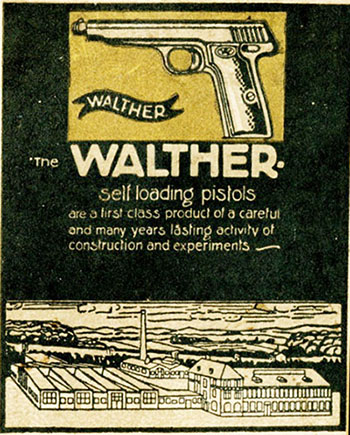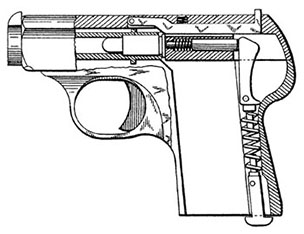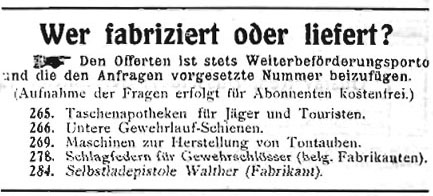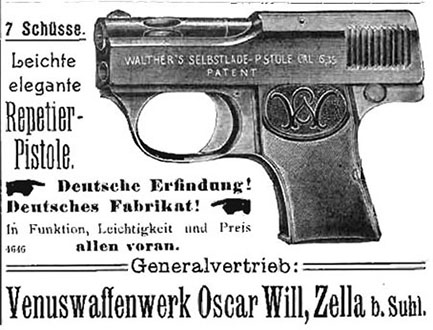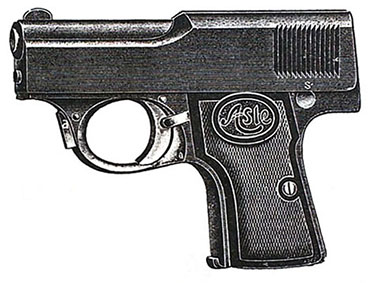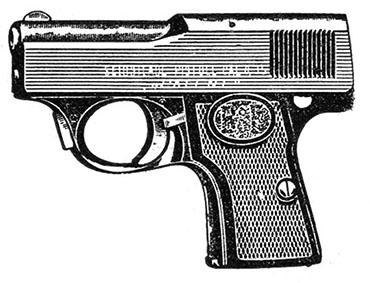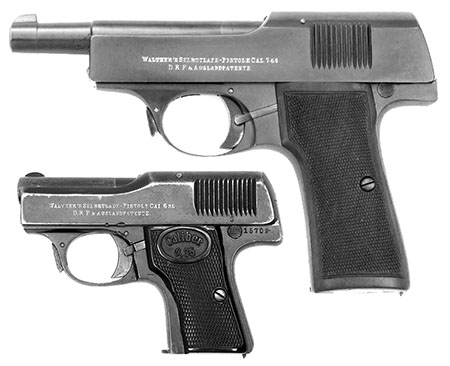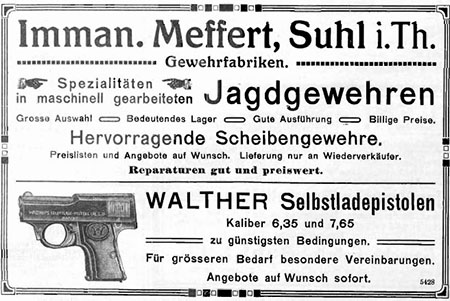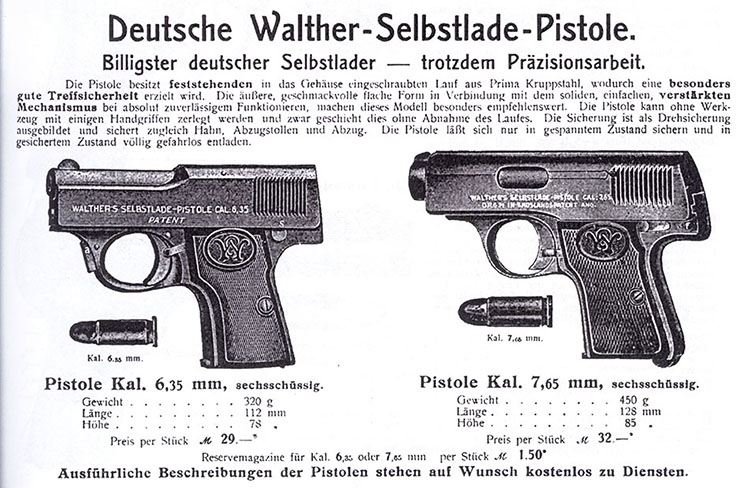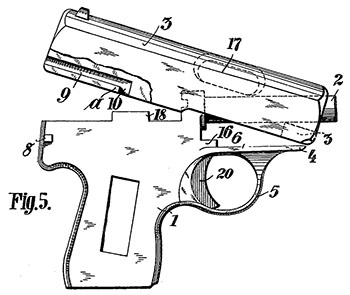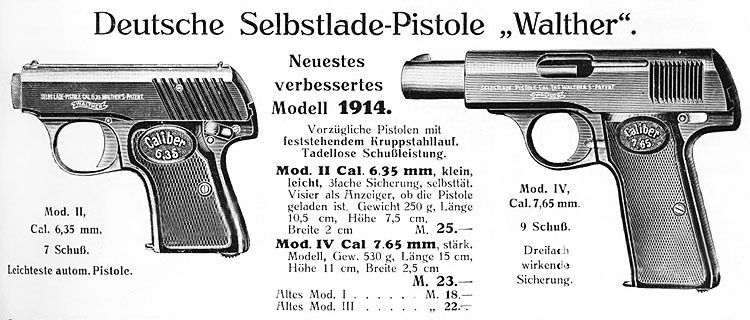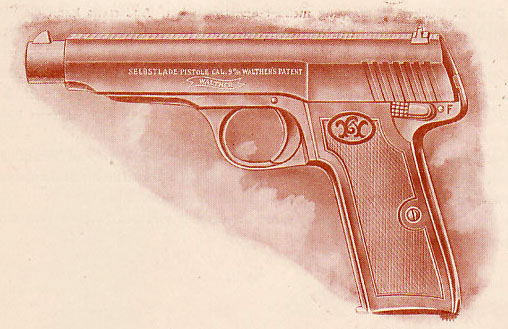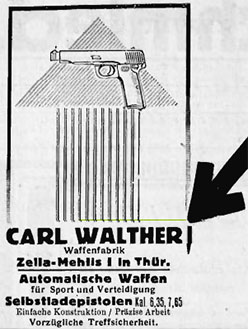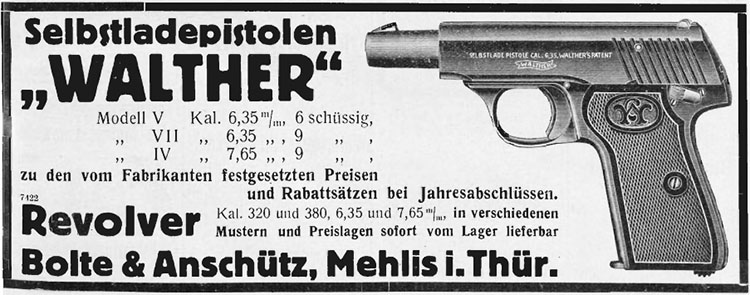 |
||||||||||||||||||||||||||||||||||||||||||||||||||||||||||||||||||||||||||||||||||||||||||||||||||||||||||||||||||||||||||||||||||||||||||||||||||||||||||||||||||||||||||||||||||||||||||||||||||||||||||||||||||||||||||||||||||||||||||||||||||||||||||||||||||||||||||||||||||||||||||||||||||||||||||||||||||||||||||||||||||||||||||||||
|
Dating the Early Walther Pistols, by Ed Buffaloe
Some may be surprised that the Model 3 should predate the Model 2. I have reached the same conclusion as Gangarosa, though I would date the Model 3 even earlier. The Walther company created the model numbers for early pistols probably sometime after production of the Model 4 had begun. Model numbers were not assigned at random but, despite the numerical sequence, there is clear evidence for the precedence of the Model 3 (see below). Dieter Marschall’s dates for early Walther pistols have evolved somewhat over the years. In the first English edition of his book, from the year 2000, he gives 1908-1909 as the likely years for Walther Model 1 production, 1902-1910 for Model 2 production (possibly a misprint), 1910-1913 for Model 3 production, and 1910-1928 for Model 4; whereas in the 2016 third English edition he gives 1910-1915 for Model 1 production, and suggests that the Models 2, 3 and 4 all date from 1913, with Model 2 and 3 production likely ending around 1915 and Model 4 production ending as late as 1928 or 1929. None of the above-mentioned writers give reasons for the dates they have determined. My goal is to examine all of the evidence and present it for the reader. I will also offer some comments on nomenclature for the Models 2 and 5. It may be impossible to reach firm conclusions because some of the evidence is contradictory—so a certain level of speculation and opinion will have to be tolerated.
There are three relevant patents relating to the first four models, each of which is specific to a single aspect of design, though the patent drawings sometimes tell a more detailed story than the claims of the patents themselves. German patent 235944 - filed 8 August 1909 - granted 22 June 1911
Austrian patent number 54841 was filed 23 May 1910 and granted 15 April 1912. U.S. patent number 991398 was filed 9 June 1910 and granted on 2 May 1911. The U.S. patent also only covers the method of assembly and disassembly, but has additional drawings that show more of the inner workings of the gun. The significance of the patent dates will become more evident when we discuss the various Model 1 slide inscriptions below. German patent 256606 - filed 22 October 1911 - granted 17 February 1913 This patent covers the method of assembly and disassembly for a gun with a fixed barrel wherein the recoil spring surrounds the barrel and the breech block [slide] is held on by a bushing at the front which also serves as “an abutment for the recoil spring”. The patent specifically states that the bushing at the front of the slide is “secured by means of a bayonet catch”. This detail is important because the Model 3 does not have the bayonet catch, whereas the Model 2 does have one but the lockwork on the two guns is virtually identical (though reversed) and matches that shown in the patent.
U.S. Patent 1059581 was filed on 15 December 1911 and granted 22 April 1913. The U.S. patent features additional drawings of the lockwork of the pistol, and the claim, while mentioning the fixed barrel, does not refer to the method of assembly and disassembly which are illustrated in the patent drawing but instead focuses on the design of the lockwork. German patent 271863 - filed 8 January 1913 - granted 19 March 1914 This patent covers the rear sight which serves as a loaded-chamber indicator. The patent, and later Walther literature, refers to it as an automatic sight, only visible when the chamber has a cartridge in it.
The Walther Model 1
The Model 1 patent was filed on the 8th of August 1909; it had not yet been granted a year later, in 1910, but the gun was clearly already in production, since Walther was looking for a distributor. With the patent having been filed in late 1909, we can assume that at least a few prototypes were in existence and, as Gangarosa suggests,
Only two months after the September advertisement seeking a distributor, in November 1910 we see the first advertisement for the Walther Selbstladepistole in Waffenschmied, offered by the firm Venuswaffenwerk Oscar Will, of Zella, the same town in Thuringia where Walther was based. The advertisement reads: “Light, elegant repeater-pistol. German invention! German make! Function, lightness and price above all else.” The drawing shows a gun with flutes on the barrel sleeve, just behind the front sight—perhaps the flutes were a feature of some early prototypes, though I have not seen them in any Model 1 I have documented. Turning now to Walther Model 1 slide inscriptions, we note that the earliest Model 1 pistols have an inscription that reads D.R.G.M. IN-&AUSLANDSPATENT ANG., indicating that a gebrauchsmuster (also known as a utility model, a limited form of patent) and both national and foreign patents have been applied for. No gebrauchsmuster has ever been found, but the assertion that national and foreign patents have been applied for indicates that these pistols were produced after the patent application date of 8 August 1909. I have documented the D.R.G.M. IN-&AUSLANDSPATENT ANG. inscription at least through serial number 6187, though occasional earlier serial numbers (2373 and 4096) feature the word PATENT but lack the Walther name. The D.R.G.M. IN-&AUSLANDSPATENT ANG. inscription would seem to preclude a manufacture date in 1908 but, if a gebrauchsmuster had actually been filed, the 1908 date would still be possible. I also note the use of the crown-over-crown-over-U proof mark on early Walther Model 1 pistols through at least serial number 2670. My database of early Model 1 pistols is limited, but at this time I estimate that only about 3000 Model 1 pistols had been made prior to September 1911 when the Zella-Mehlis proof was changed to crown-over-N. Considering this, use of the D.R.G.M. IN-&AUSLANDSPATENT ANG. slide inscription may have continued after the patent was granted on 22 June 1911, since we find this inscription at least up to serial number 6187, or perhaps the slides had already been stamped but the guns had not yet been proofed. The occasional early pistol with a generic inscription and the word PATENT on the slide (lacking the Walther name) were intended for sale by a retailer who would have supplied his own brand name. This assertion is based on advertisements for the Model 1 in the 1912 August Stukenbrok catalog and in an undated Bial & Freund catalog.
Later slide inscriptions for the Model 1 are found above the Walther banner. According to Manfred Kersten, “The Walther banner...was applied for on 8 October 1912 and registered as a protected trademark on 12 November 1912.” This indicates that the banner might not have been seen on the Model 1, even in the early “flat” form, until very late in 1912. Production of the Model 1 may have ended by 1914 but it was still being sold from stock in this first year of the war.
I have documented a 7.65mm (.32 caliber) Walther pistol, made on the Model 1 pattern, with a “D.R.P. & AUSLANDSPATENTE” slide inscription (such as is found on later Model 1 pistols) indicating that both national and foreign patents had been granted. I presume this gun was made after the Model 1 patent was granted in June 1911, because of the inscription and also because it has the crown-over-N proof. But the Model 3 was likely already in the works. The Walther Model 3 It seems almost certain that, as Gangarosa suggested, the Walther Model 3 preceded the Model 2 because it was already being offered for sale in early 1912. In February 1912, four months after Walther’s second pistol patent was filed but well before it was granted, we find an advertisement in Waffenschmied for both 6.35mm and 7.65mm Walther pistols, offered by Immanuel Meffert. Similar advertisements are found throughout the rest of the year, even though none of the advertisements actually show a picture of a 7.65mm pistol—only of the Model 1.
The Model 3 patent had been applied for in October of 1911. It seems very likely that early Model 3 pistols were produced and sold before the patent (256606) was actually granted in February of 1913. Production probably started as soon as the patent was filed, since 7.65mm pistols were advertised by Meffert in February 1912. I am surprised at this discovery since Walther was careful, with the Model 1, to indicate in their early slide inscriptions that domestic and foreign patents had been applied for, and later indicating that patents had been granted. This violation of the usual protocol is probably the reason that the Model 3 was not illustrated in advertisements until after the patent was granted. The first advertisement with a picture of the Walther Model 3 is from the 1913 Gecado catalog where it appears next to a Model 1. There are still no model numbers assigned to the guns at this time—the two pistols are advertised as the “Walther Selbstlade Pistole Kal. 6.35mm” and the “Walther Selbstlade Pistole Kal. 7.65mm”. But notice that the inscription on the 7.65mm pistol says D.R.G.M. IN-&AUSLANDSPATENT ANG. I have never observed such an inscription on a Model 3.
The gun described in the text of the advertisement is definitely the Model 3: “The pistol has a fixed barrel made of prime Krupp steel that is screwed into the housing, which ensures particularly good accuracy. The external, tasteful, flat shape in connection with the solid, simple, reinforced mechanism with absolutely reliable functioning make this model particularly recommendable. The pistol can be disassembled in a few simple steps without tools and this is done without removing the barrel. The safety is designed as a twist lock and secures the hammer at the same time as the sear and trigger. The pistol can only be secured when it is cocked and can be unloaded without any danger when it is in the secured condition.”
We find the same progression of slide inscriptions and banners on the Model 3 as we find on the Model 1, with the exception that there are no Model 3 pistols with the inscription “D.R.G.M.”, to indicate that a gebrauchsmuster had been filed, nor any “patent applied for” inscription. The early Model 3 pistols have a simple slide inscription on the left side that reads “SELBSTLADE-PISTOLE CAL.7,65 WALTHER’S-PATENT”, with no banner. Later pistols have the same inscription above the early Walther banner which has become known among collectors as the “flat” banner.
Late Walther Model 1 and Model 3 pistols featured a more refined-looking banner with a more significant curve.
My best guess is that the more refined, curved Walther banner probably originated sometime in late 1913 or early 1914. Very late Model 3 pistols have this late banner, as do even the earliest Model 2 and 4 pistols I have documented. The Walther Models 2 and 5 Gangarosa, as quoted above, stated that “...the Model 2’s introduction was delayed until 1914.”, citing “contemporary catalogs” and stating that “...patents for the new design were not applied for until late 1911 to early 1914.” The latter is a slight mis-statement, since the second patent was actually applied for in 1913 though it was not granted until March of 1914. I have concluded, above, that the Model 3 was sold before the patent was granted, so why not the Model 2 as well? —Because every Model 2 I have documented has the late, fully curved, Walther banner, which I believe did not appear until after the Model 3 was well into production. The first advertisement I have found for the Model 2 is also the first advertisement I have found for the Model 4, and this advertisement likely dates from late 1914.
The guns are described as the “latest improved Model 1914...pistols,” while the Model I and Model III are also listed at slightly cheaper prices. Take especial note that the cost of the Model II is higher than that of all the other models, including the Model IV; and also note that the company claims a triple safety, specifically mentioning the “sight to indicate if the pistol is loaded” while tacitly including the manual safety and magazine safety. “Triple safety” is a claim also made by FN for its Browning Model 1910 pistol (first manufactured in 1912), which had a manual safety, a grip safety, and a magazine safety; so clearly Walther was looking to compete with FN. The Model 2, having a more complex mechanism than the other guns, is priced accordingly. Unfortunately, as a result of costing more than the larger and more powerful Model 4, and probably also as a result of the start of World War I on 28 June 1914, the Model 2 with the “automatic sight” never sold well and is quite scarce today. Due to its high price, the Model 2 did not seem like a bargain to a thrifty and practical German gun buyer. Judging from the advertisement above, the marketing of the Model 2 was based on the new features of an automatic sight and a magazine safety. Interestingly, though, we find a statement from Fritz Walther which is given on page 67 of the English edition of Manfred Kersten’s book Walther, A German Legend. Kersten does not give the source or date of this statement, but it is worth quoting from because it speaks of two differing designs: The design, with various, ingenious innovations, is protected by Reichs patents and foreign patents, as well as by several registered designs [gebrauchmusters, i.e., utility models?]. Both models share a fixed barrel and a spring-recoiled slide without being mechanically locked. The outer shape, naturally adapted to the hand as well as the slide construction, is the same for both models. The following description is therefore not only true for the pistol with automatic sights, but also for the pistol with a sight groove. The above quote from Fritz Walther clearly indicates that both a pistol with “automatic sights” and a pistol with a “sight groove” were being manufactured at the same time. While he does use the term “both models”, he does not refer to the model numbers, leading us to believe that model numbers may not have been assigned when he made this statement. Since the patent for the automatic sight was not granted until March 1914, we might assume that Walther would have marketed the gun with the sight groove first; however, this appears not to be the case. Dieter Marschall, who has a more complete database of Model 2 pistols than I do, indicates that the “automatic sight” pistols begin around serial number 1000, whereas the earliest “sight groove” pistol he has documented is 1770. Please contact me if you have an early Walther Model 2.* This leads us to the fact that there has been some confusion among collectors as to the exact difference between the Walther Model 2 and the Walther Model 5 Gangarosa clearly believes that the Model 2 is a gun with nine flat-milled slide serrations, and the serial number on the right side, whether it has an “automatic sight” or not. Gangarosa says: “Because the late Model 2 (without the pop-up rear sight) and the Model 5 are almost identical, it’s difficult to tell exactly whether a given pistol is a Model 2 or a Model 5.” He seems to believe the true difference lies in the barrel grooves, stating that the Model 2 has four grooves, whereas the Model 5 has six, but I find this unconvincing and nearly impossible to verify.
Perhaps there was originally no clear distinction between the Model 2 and Model 5; perhaps they were a single design with different features. But it seems clear that, early on, the company began to refer to the “automatic sight” pistol as the Model 2 and the sight-groove pistol as the Model 5, and this is reflected in all published manuals of the era. Only later, after the war, was the Model 5 redesigned to feature sixteen fine triangular-cut slide serrations, and the serial number was moved to the left side. The Walther Model 4 Smith, Rankin, and Kersten all state that the Model 4 dates to 1910, though the patents clearly indicate a later date. Gangarosa believes the Model 4 did not appear until 1915, but Marschall believes it may have been produced as early as 1913. In the above advertisement, probably from late 1914, it is designated the Model 1914, so it seems likely that production began in early 1914 though an earlier date cannot be ruled out entirely. The gun pictured in the 1914 GECO catalog is the Type I, utilizing an identical slide to that on the Model 3. There are some scarce Model 3 pistols with the longer barrel of the Model 4, suggesting that the two guns were in production at the same time. The patent upon which the Models 2 through 7 are based dates back to 1911 so a production date of 1913 for early Model 4 pistols is not out of the question but, lacking further evidence, 1914 seems a reasonable compromise. It might have been rushed into production after the war began, on 28 June 1914, but firm evidence for this scenario is also lacking. There is an English-language manual which covers the Models 4, 5, 6, and 7. This manual was almost certainly intended for buyers of Walther pistols in the United States, which did not enter the war until 6 April 1917 and so remained a viable market for the Walther company at least until that date. I suggest that the manual likely dates from either 1915 or 1916, and I lean toward the later date because the illustration of the Model 4 shows a Type 2 and 1916 seems to be the pivotal year for production of the Model 6 which is also included in the manual.
The Walther Model 6 Of the Walther Model 6, W. H. B. Smith says: “In 1915 the German Army, then officially armed with the 9mm Luger, found itself in dire need of additional sidearms. Walther tooled up to manufacture a pistol of the type of the low powered model 4 which would handle the Luger Cartridge.” Smith later states that “...manufacture of these weapons was discontinued in 1917 and never resumed...” Rankin, Kersten, Still, and Marschall also give the dates 1915 to 1917, though Marschall puts a question mark after 1915. Gangarosa says only: “...Walther had to stop production of the Model 6 in early 1917...” However, Jan Still states that: “In August 1917 the German Army Arsenal offered the Walther Model 6 for sale to officers for 48 Marks.” The undated German language manual for the Model 6 says: “The surprisingly good success that the Walther self-loading pistols, caliber 7.65 and 6.35 mm, have had in the present war, prompted the Walther weapons factory to bring out the pistol caliber 9 mm, set up for the army cartridge 08.” But the gun proved insufficiently robust to withstand the pressures generated by the 9mm Parabellum cartridge and so production was quickly curtailed.
I find no advertisements for the Walther Model 6, which was very short lived, though the gun is illustrated in an advertisement for the smaller caliber pistols. I have collected Model 6 serial numbers ranging from 573 to 1032, so at this time I estimate that only about 500 were made. It seems likely, lacking further information, that most production took place in 1916. The Walther Model 7 W. H. B. Smith, James Rankin, and Manfred Kersten all date the Model 7 to 1917, whereas Gene Gangarosa and Dieter Marschall both give 1915. The only evidence I have found regarding a possible date is an advertisement in Waffenschmied for 25 July 1916. The advertisement includes the Models 4, 5 and 7, with the Model 7 being illustrated.
Clearly the Model 7 was already in production by mid-1916, so I suspect the 1915 date is accurate. The most common end date given is 1919. The Model 8 patents were all filed between June and December of 1919, but the earliest one granted was in September 1920, so I suspect Model 7 production may have continued until at least that date.
On 1 April 1919 the governments of the towns of Zella-St. Blasii and Mehlis merged to form a single government for the new town of Zella-Mehlis. Walther soon began stamping all their pistols with the new address, and this change can be used to approximately date the Model 4, Model 5, and Model 7. It was shortly after this change of address that slide serrations for the Model 4, Model 5, and Model 7 were changed from wide flat-milled to fine triangular-cut. * If you own any of the early Walther pistols mentioned in this article, I would very much like to have photographs of your gun and any information you would care to share about it. Write to me at edbuffaloe@unblinkingeye.com. |
||||||||||||||||||||||||||||||||||||||||||||||||||||||||||||||||||||||||||||||||||||||||||||||||||||||||||||||||||||||||||||||||||||||||||||||||||||||||||||||||||||||||||||||||||||||||||||||||||||||||||||||||||||||||||||||||||||||||||||||||||||||||||||||||||||||||||||||||||||||||||||||||||||||||||||||||||||||||||||||||||||||||||||||
|
||||||||||||||||||||||||||||||||||||||||||||||||||||||||||||||||||||||||||||||||||||||||||||||||||||||||||||||||||||||||||||||||||||||||||||||||||||||||||||||||||||||||||||||||||||||||||||||||||||||||||||||||||||||||||||||||||||||||||||||||||||||||||||||||||||||||||||||||||||||||||||||||||||||||||||||||||||||||||||||||||||||||||||||
|
Copyright 2023 by Ed Buffaloe. All rights reserved. |
||||||||||||||||||||||||||||||||||||||||||||||||||||||||||||||||||||||||||||||||||||||||||||||||||||||||||||||||||||||||||||||||||||||||||||||||||||||||||||||||||||||||||||||||||||||||||||||||||||||||||||||||||||||||||||||||||||||||||||||||||||||||||||||||||||||||||||||||||||||||||||||||||||||||||||||||||||||||||||||||||||||||||||||
|
|
||||||||||||||||||||||||||||||||||||||||||||||||||||||||||||||||||||||||||||||||||||||||||||||||||||||||||||||||||||||||||||||||||||||||||||||||||||||||||||||||||||||||||||||||||||||||||||||||||||||||||||||||||||||||||||||||||||||||||||||||||||||||||||||||||||||||||||||||||||||||||||||||||||||||||||||||||||||||||||||||||||||||||||||
